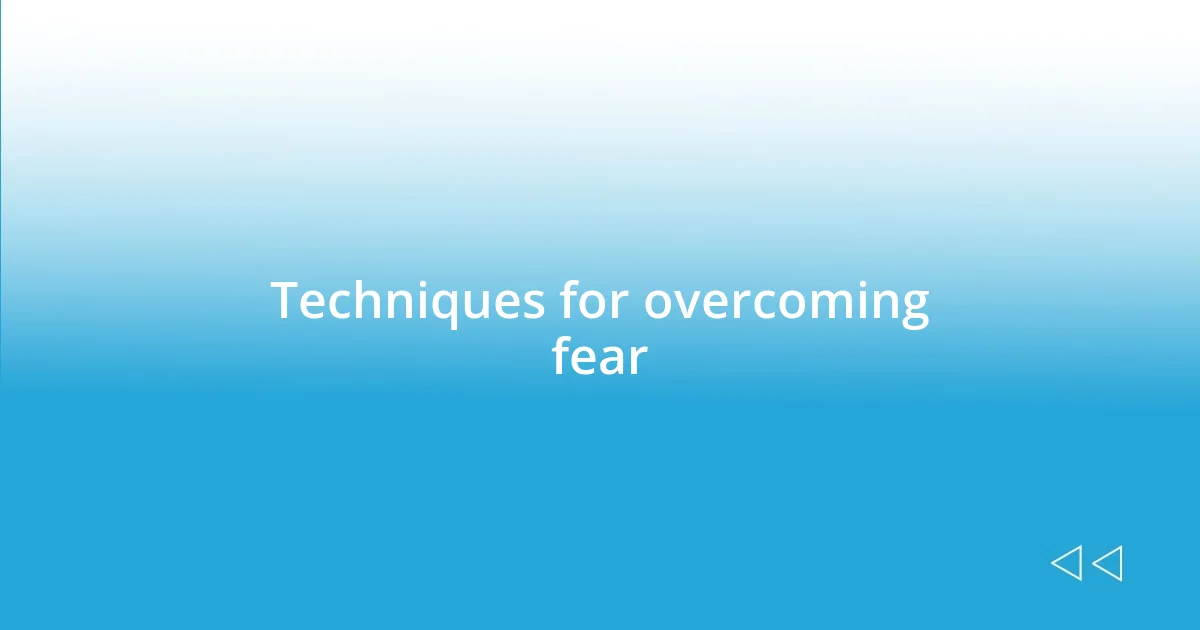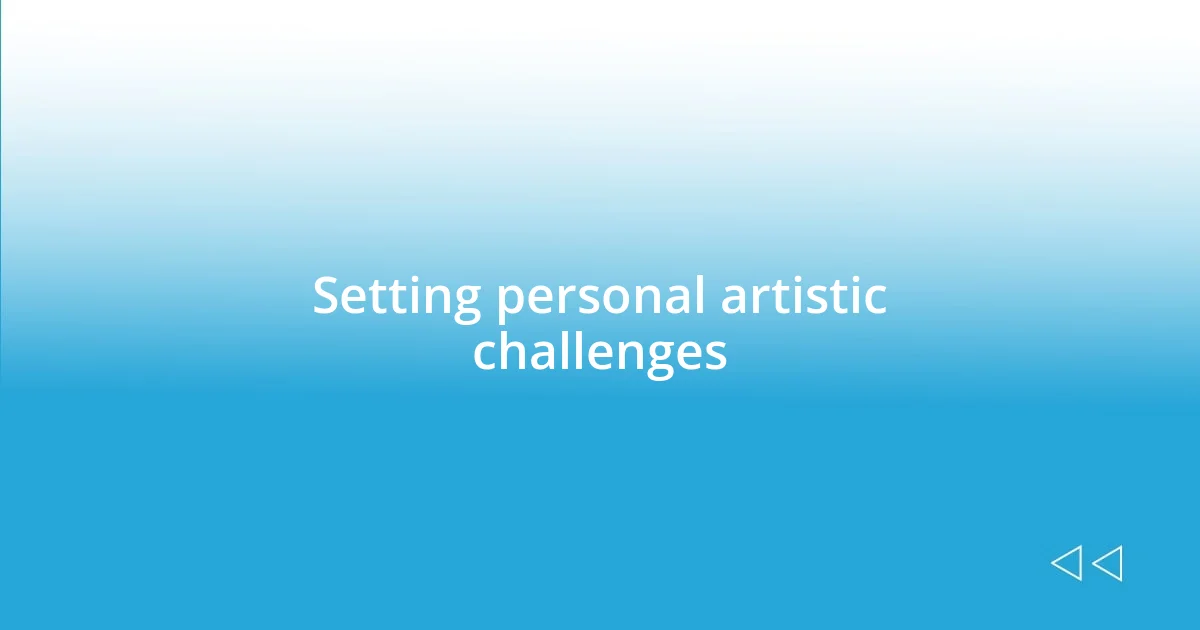Key takeaways:
- Artistic motivation is fueled by personal experiences, community support, and the excitement of experimentation.
- Curiosity and risk-taking drive creativity, encouraging artists to explore unconventional methods and embrace mistakes as opportunities for growth.
- Developing a sustainable practice through mindful material selection and establishing routines enhances both creativity and environmental responsibility.

Understanding artistic motivation
Artistic motivation often springs from a deep-seated desire to express oneself. I remember standing in front of a blank canvas, feeling a rush of emotion as I contemplated the thoughts swirling in my mind. Isn’t it fascinating how personal experiences, both joyous and painful, can ignite a creative spark that compels us to create?
Sometimes, I find that the act of experimentation itself drives my motivation. For instance, when I first tried mixing unexpected colors, the thrill of discovery energized me. Have you ever felt that excitement when you stumble upon an unexpected combination? It’s like finding a hidden treasure within your own imagination.
Additionally, community can play a pivotal role in artistic motivation. I once joined a local art group where sharing ideas and feedback transformed my approach to creativity. How can the energy and support of others shape your artistic journey? In my experience, those connections can warm the heart and inspire new directions that we never anticipated.

The role of curiosity
Curiosity acts as a powerful catalyst for artistic exploration. I remember a time when I was wandering through a local art fair and stumbled upon a mixed media piece that combined materials I had never considered using before. The sheer intrigue of how the artist had layered textures sparked something within me, pushing me to experiment with unconventional elements in my own work. Isn’t it incredible how encountering something unfamiliar can shift our perspective entirely?
- Curiosity drives exploration: It encourages me to seek out new mediums, techniques, and ideas.
- It fosters learning: Each new discovery can lead to an “aha” moment, inspiring further experimentation.
- Curiosity builds connections: Engaging with fellow artists can open new doors and insights I might not have found on my own.
- It fuels resilience: When a project doesn’t go as planned, my curiosity pushes me to view it as a stepping stone rather than a dead end.
When I allow my curiosity to lead, I find myself not just creating art, but embarking on a personal journey full of unexpected twists. Each experiment becomes a nail-biting adventure, revealing layers of insight about both the artwork and myself. It’s in these moments of wonder that I feel most alive as an artist, reminding me of the endless possibilities that await just beyond my comfort zone.

Embracing creative risk-taking
Embracing creative risk-taking has become a cornerstone of my artistic journey. I recall the first time I decided to paint on an unconventional surface—a piece of old wood that I almost tossed aside. As I dipped my brush into vibrant colors, there was a palpable sense of freedom in letting go of traditional methods. It was exhilarating, like stepping off a cliff and trusting the air would hold me. Have you ever felt the rush of diving into the unknown? It’s those moments that redefine our creative boundaries.
Taking risks often leads to surprising outcomes. I vividly remember experimenting with a new technique that involved pouring paint rather than applying it with a brush. The initial chaos felt intimidating, but slowly, I began to see a beautiful mess emerge. Each drip and splash told a story I hadn’t anticipated. How often do we shy away from such uncertainty? I’ve learned that embracing the mess can lead to profound discoveries about my style and voice.
These experiences have taught me that risk-taking doesn’t just enhance my art; it fuels my passion for creation itself. It’s become a dance between anxiety and excitement, where each step forward fills me with a sense of adventure. Isn’t that what makes being an artist so special? The thrill of not knowing where a bold choice may lead can open doors to new dimensions of creativity that we never imagined possible.
| Aspect | Risk-Taking |
|---|---|
| Emotional Experience | Exhilaration |
| Outcomes | Surprise and Discovery |

Techniques for overcoming fear
Working through the fear of experimentation can feel daunting, but I’ve found that structured techniques can truly help. One method I often use is setting small, manageable goals. For instance, when I feel stuck, I’ll challenge myself to create just one sketch using an unfamiliar tool or medium. It shifts my focus from the overwhelming fear of failure to enjoying the simple act of creation.
Another powerful technique is reframing my perspective about mistakes. I remember a time when a canvas turned into a total disaster. Instead of discarding it, I decided to transform the “failure” into a new piece, painting over it with layers that told its story. That experience taught me that what seems like a setback can often become a springboard for creativity. Have you considered how your so-called failures might be the very key to unlocking your next masterpiece?
Finally, surrounding myself with a supportive community significantly softens my fear. I often share my worries with fellow artists who understand the struggle of stepping outside their comfort zones. Their encouragement has reminded me that vulnerability is part of the artistic journey. When I express my fears openly, I discover that I’m not alone. Isn’t it liberating to realize that many of us are navigating these same emotions together?

Finding inspiration in everyday life
Every day, I find inspiration in the smallest moments around me. Just last week, while waiting for my coffee, I watched the barista artfully swirl milk into a cup, creating an intricate pattern. The fluid motion reminded me that art isn’t confined to traditional canvases; it can emerge from the most mundane experiences if we simply pay attention. Have you ever noticed how a simple act can spark creativity?
Sometimes, inspiration strikes in unexpected places, like during a stroll through my neighborhood. I remember one afternoon, I lost myself in the colors of autumn leaves as they danced in the wind. Each hue, from fiery reds to soft yellows, conjured up ideas for a new color palette in my latest project. That kind of connection to nature can ignite a deeper understanding of my emotional landscape. Have you felt nature’s pull to inspire your work?
Even conversations can be a wellspring of creativity. A casual chat with a friend about their dreams and fears once led me to create a series of portraits reflecting their emotional journey. I realized then that our surroundings, relationships, and daily interactions can fuel our artistic expression. How do you engage with the world to find your muse? It’s fascinating to discover that inspiration is everywhere; we just need to open our eyes and hearts to it.

Setting personal artistic challenges
Setting personal artistic challenges can be a game changer in my creative process. I often set myself a specific task, like painting daily for a whole month, where each piece builds on the last. This not only stretches my skills but also helps me develop a unique voice in my work. Have you ever committed to such a challenge?
Embracing constraints has led me to remarkable discoveries. Last year, I picked a theme for a series—“the passage of time”—and forced myself to work exclusively in black and white. At first, it felt limiting, but those boundaries pushed me to focus on texture and form in ways I hadn’t considered before. It was a beautiful reminder that sometimes, restrictions can lead to creativity rather than stifle it.
One of my most exhilarating challenges was collaborating with a friend on a project using only recycled materials. We’d sort through everything from discarded cardboard to old magazines. What started as a simple exercise turned into a heartfelt exploration of our shared values about sustainability, inspiring deeper conversations about our impact on the world. Have you thought about how collaboration might enhance your artistic practice? Engaging with others can open up new perspectives and ignite fresh ideas, transforming the artistic journey into a shared adventure.

Developing a sustainable practice
Developing a sustainable practice is something I deeply value in my artistic journey. A few months ago, I made a conscious decision to incorporate more environmentally friendly materials into my work. I remember the rush of excitement as I sifting through secondhand stores, aware that each purchase not only supports local businesses but also reduces waste. Have you ever felt that thrill of breathing new life into something discarded? It’s like a treasure hunt that fuels not just my creativity but also my commitment to sustainability.
I’ve also found that establishing a routine is key to maintaining a sustainable practice. Each morning, I dedicate an hour to creating art, whether it’s sketching, painting, or experimenting with various techniques. This consistent commitment helps me stay connected to my work, and I’ve noticed that the more regularly I engage with my art, the more ideas flow naturally. Does having a routine resonate with you? I believe it can help harness both inspiration and discipline.
Additionally, I try to reflect on the impact my artistic choices have on the environment. For instance, shifting to natural dyes for my fabric projects was a beautiful revelation. I vividly recall the moment I watched beet juice transform a piece of cloth into a rich crimson; it felt like I was merging creativity with ecological consciousness. Have you considered the materials you use in your art? Embracing a thoughtful approach not only enhances my work but also fosters a sense of responsibility towards the planet.













